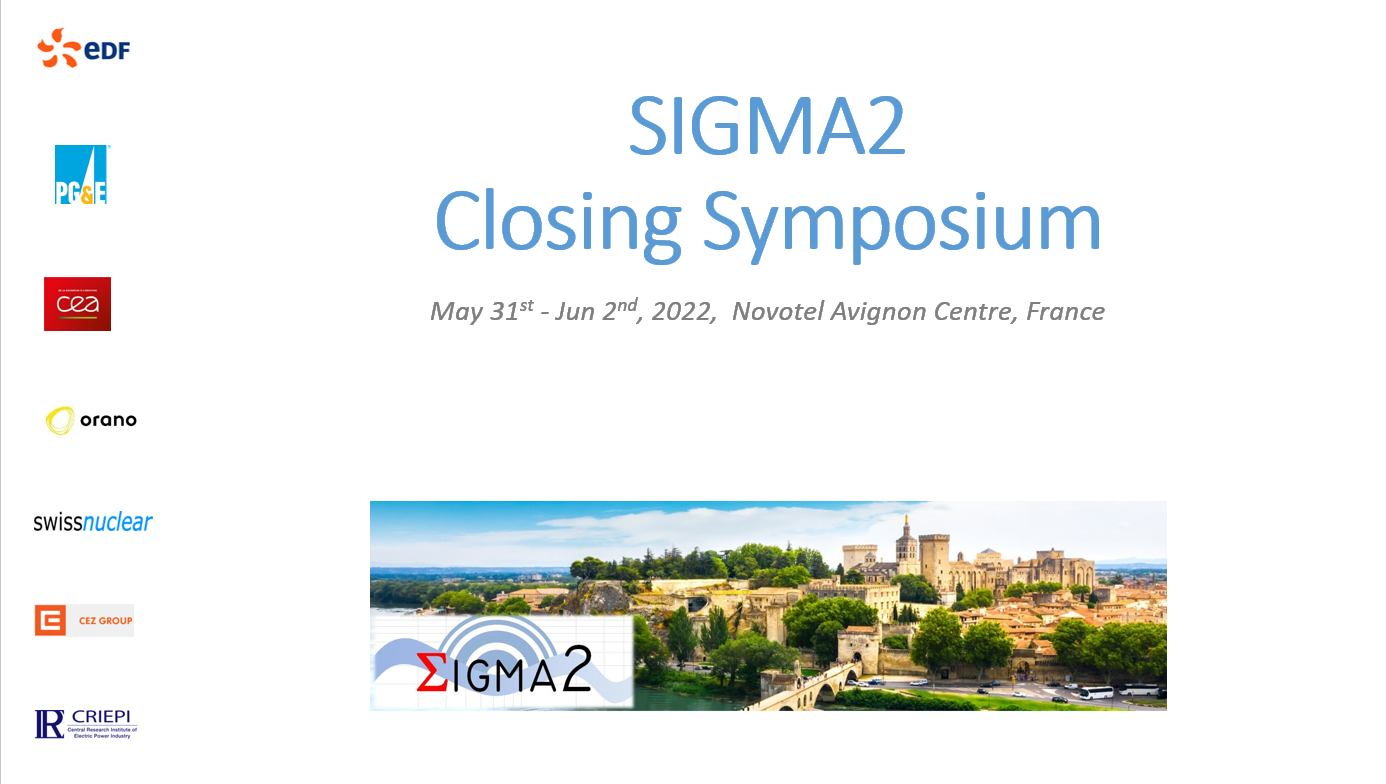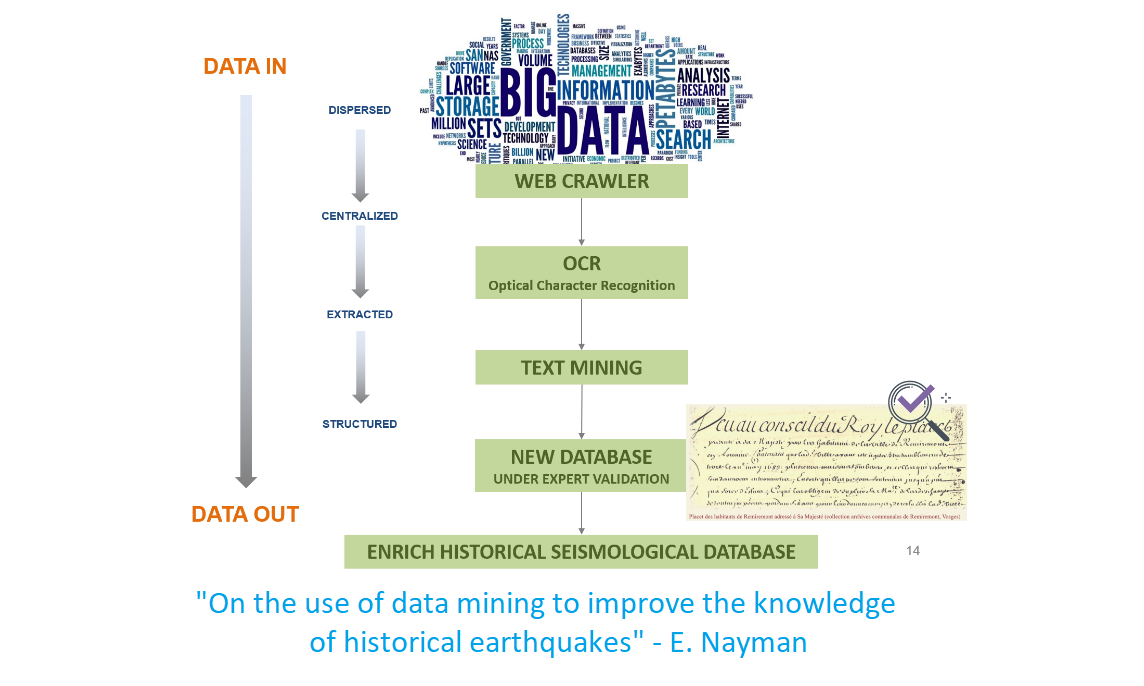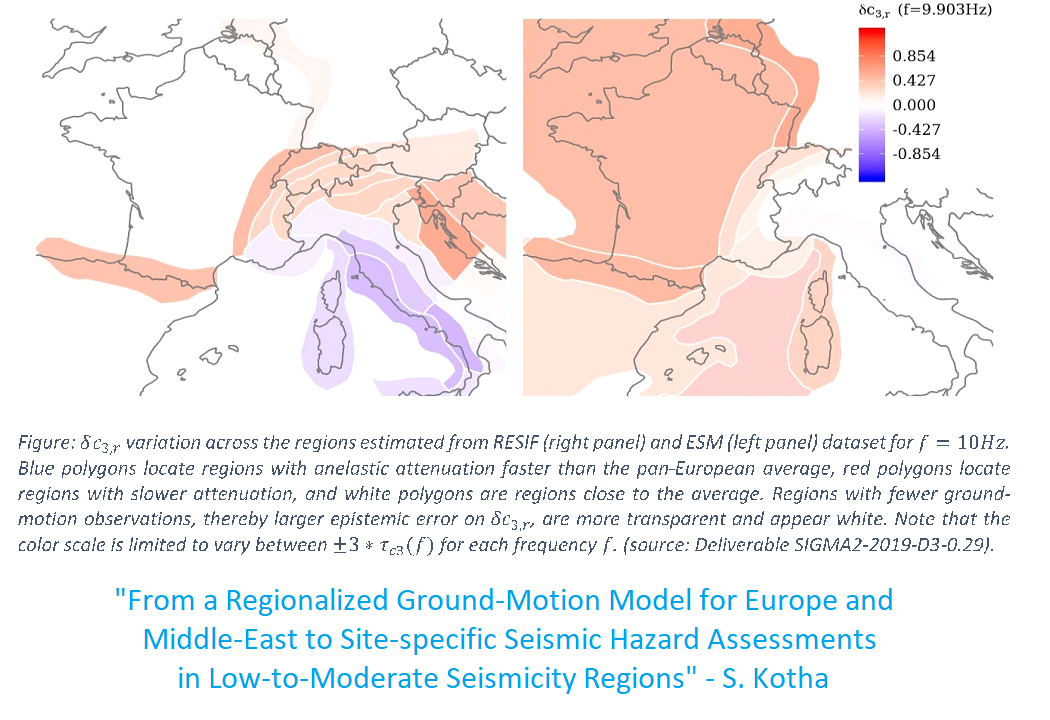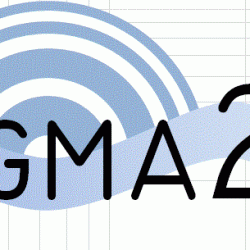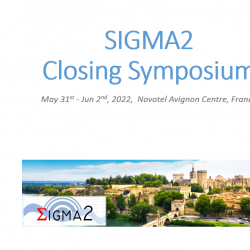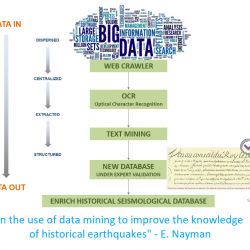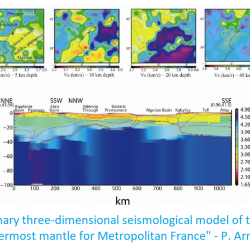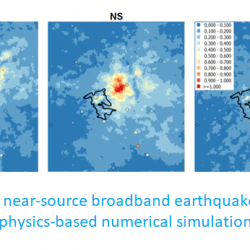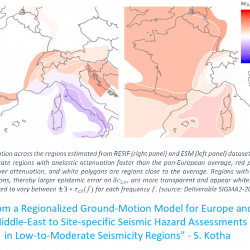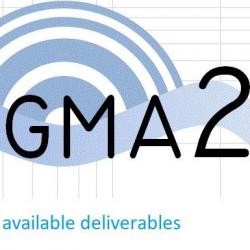Ground motion for engineering
Motivation & Objectives
This work package aims at producing data and results for engineering purposes and at bridging the gap between PSHA results and earthquake engineering practices.
The research actions in this Work Package will focus on:
- methodologies for the use of Conditional (Mean) Spectra in an industrial context
- new approaches for the selection of time-histories matching a specific response spectrum
- the implementation of advanced representation of ground-motion (power spectral density)
- a seismic risk assessment study performed in the (macroseismic) intensity domain based on waveform modeling and fragility curves calibrated against site intensities.
Coordination
Julien BERGER (EDF) & Gloria SENFAUTE (EDF)
Actions
Response spectra for design and risk calcultations
Motivations
UHS as design spectra is not suitable to best-estimate or performance-based seismic analysis. Another way is to use multiple scenarios rather than the UHS in order to obtain more realistic seismic broad band excitations. However, the definition of target spectra that comply with design requirements while being hazard-consistent for a reduced number of structural analyses is not straightforward.
Program of research
The aim is to develop and test alternative methods to the UHS allowing to define design spectra compatible to an industrial context.
Work plan includes 4 main topics:
- State of the art of Conditional Mean Spectra (CMS) / Conditional Spectra (CS) methodologies
- Implementation of CMS / CS methodology or methodologies selected
- Application of CMS / CS methodology in a pilot site (have to be defined), including a comparative study with other more classical method (UHS, decomposition of UHS by others methods…).
- To develop a comprehensive methodology that would be feasible in an industrial context.
- Guide / Recommendations for generating CMS from a PSHA and on the associated use of the results for nuclear facilities
Organization
Funding member: EDF
Type: PhD in link with WP5 and Post-doc
Collaboration: Pavia University (IUSS), Itlay; IFSTTAR, Paris; CNRS
Status: in progress
Results
Report
Selection of time histories
Reports available! ![]() On the Selection of Natural and Synthetic Time histories fos Engineering Practice (5.79 Mo)
On the Selection of Natural and Synthetic Time histories fos Engineering Practice (5.79 Mo)
Motivations
Various practices tend to favor either synthetic time histories or natural recorded time histories, with a greater inclination towards natural time histories (modified or not). However, there is a lack of objective comparisons between both methods with regards to the damages to structures and facilities.
The aim is:
- To demonstrate that if the same effort is put on the selection of the time histories either modified natural or synthetic ones, then the use of synthetic time histories allows reaching at least the same level of quality of results in terms of damages to structures and facilities even for non-linear studies
- To make available to Engineering the selection process of sets of time histories.
Program of research
Work plan includes 2 main topics:
- Development of simple non-linear oscillators in Code-Aster from Humber et al. (2014) and Viallet et al. (2017),
- Evaluation of the criteria relevance for the selection or generation of time histories by comparison with ones from Strong Motion Database.
The deliverable is a tool for the assessment of the quality of sets of time histories.
Organization
Funding member: EDF
Type: Post-doc
Collaboration: Pavia University (IUSS), Italy; CNRS
Status: in progress
Results
Report
A better representation of the seismic motion for the engineers
Reports available! ![]() The potential interest of the combination of PSD and RVT in seismic studies for nuclear installations (2.55 Mo)
The potential interest of the combination of PSD and RVT in seismic studies for nuclear installations (2.55 Mo)
Motivations
Development of computation capacities and codes tends to give access to more evolved methods for representing the seismic motion and for modelling the structural/mechanical response.
The aim is:
- To investigate the potential of new approaches to evaluate the dynamic response of structures and its need in terms of definition of the seismic movement. The Random Vibration Theory is such a candidate,
- In link with SIGMA2 Work-Package 3, to evaluate the possibility to use or to develop adequate Ground Motion Parameters’ Equations (GMPEs) in line with the first objective.
Program of research
Work plan includes 3 main topics:
- To make some bibliography on the use of RVT for the propagation of the seismic motion into a mechanical system,
- To investigate any potential methods with similar principles to RVT: use of an advanced seismic motion representation (e.g. Power Spectra Density or Fourier Amplitude Spectra) in a method transferring itself directly at various location of interest into a building,
- To perform study cases in order to compare:
- the use of RVT for evaluating the seismic response of buildings, taking into account Soil-Structure Interaction (SSI) and the need to access to various levels of confidence,
-More traditional approaches using THs and resolution in the frequency domain.
Organization
Funding member: EDF
Type: Internship
Status: completed
Results
Report
Seismic risk assessment in intensity domain and case study
Reports available!
"Relate macroseismic intensity (EMS-98) to ground-motion parameters" by M. Fasan (5.45 Mo)
"Database of damage consistent natural synthetic seismograms" by M. Fasan (2.09 Mo)
"Develop fragility curves as a function of macroseismic intensity" by M. Fasan (2.26 Mo)
Motivation
The actual practice of seismic risk assessment for nuclear power plants is based on Uniform Hazard Spectra (UHS) derived from Probabilistic Seismic Hazard Assessment (PSHA) in the format of (pseudo) spectral accelerations. The spectral (force-based) method is still widely applied in earthquake engineering, especially in the design of systems. It is also applied in fragility analysis. This methodology has the problem that UHS in reality do not represent a uniform hazard but the weighted contribution of earthquakes leading to very different intensities at the plant site.
Program of research
The work can be subdivided into the following subprojects :
1. Develop a methodology for selecting intensity (EMS-98) compatible time-histories from available databases taking into account site classification (EUROCODE). Prepare a database of quality assured time histories for moderate earthquakes (intensity VI-VII (VIII)).
2. Develop a methodology for calibrating time-histories derived by waveform modeling against site intensities. Calibration process will be based on structural dynamic nonlinear or equivalent linear-elastic analyses of standardized buildings of a predefined vulnerability class with codes like SC SASSI or LS DYNA (or equivalent codes). For waveform modeling, methods like synthetic seismograms or kinematic source modeling will be applied. Develop a database of generated time-histories for intensities VIII-X taking into account site classification (EUROCODE).
3. Develop a methodology for defining intensity-compatible fragility functions for structures, systems and components from tests using time-histories developed in subprojects 1 and 2.
4. Develop an experimental case study using the SMART (Seismic design and best-estimate Methods Assessment for Reinforced concrete buildings subjected to Torsion and non-linear effects) building (www.smart2013.eu). The objective is to test all parameters developed in the others tasks and/or WPs (ex CAV, CMS, CS, RVT….)
Organization
Funding member: swissnuclear
Type: PhD
Collaboration: University of Trieste
Status: completed
Results
Report

